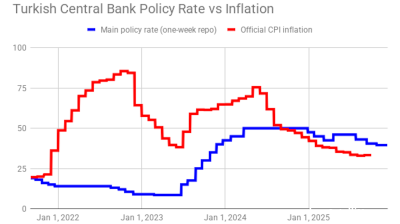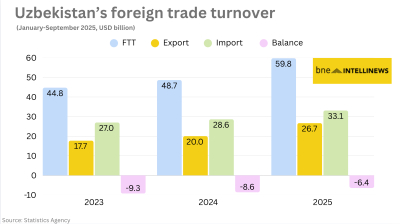Russian banks’ profit surged by more than a third to $3.3bn m/m in July, on track for another strong year
_2.png)
Russian banks’ net profit surged by more than a third (36%) month on month in July, reaching RUB306bn ($3.3bn) and putting the sector on course to have another strong year, according to preliminary data released by the Central Bank of Russia (CBR) on August 23. (chart)
Excluding the approximately RUB44bn ($481.3mn) received from Russian subsidiary banks, the sector's profits stood at 306bn, marking an RUB81bn ($885.8mn) increase from June, the CBR said in its monthly report.
Banks have shrugged off the international sanctions and already put in their strongest growth in more than five years in May. Banks’ cumulative profits YTD are currently exactly tracking last year’s performances, which were also the best in years. (chart)
The number of profitable banks rose to 250, representing 79% of all banks in July, while profitable banks accounted for 98% of the sector's total assets since the beginning of the year.
Loan dynamics
The growth of Russian consumer loans slowed to 1.4% in July, down from 2% in May and June, as higher interest rates and tightened macro-prudential regulations dampened demand. The CBR put through a whopping 200bp rate hike in July, taking the prime rate to 18%, which is also already starting to cool the economy.
The CBR has been worried about a consumer loan bubble appearing, driven by the increasing use of credit cards, and has been tightening limits recently to try to cool the market. Despite the slowdown, consumer lending remains robust, particularly in the credit card segment, which is less sensitive to key rate fluctuations, the CBR said. Rather than worry about the crushingly high interest rates, consumers using cards tend to focus on whether they can meet the monthly minimum payments.
Meanwhile, corporate lending also expanded significantly in July, with the corporate loan portfolio increasing by 2.3% (RUB1.8 trillion, $19.7bn), reaching RUB80.7 trillion ($882.8bn).
The growth was primarily driven by ruble-denominated loans, which increased by 2.6% (RUB1.7 trillion, $18.6bn). These loans were predominantly used for working capital replenishment and investment projects, including equipment acquisition. Currency-denominated loans saw moderate growth of 0.8% (RUB0.1 trillion, $1.1bn).
Sberbank, Russia's largest bank, has revised its lending growth projections upwards for the year. Retail lending is now expected to grow by 12-14% by the end of 2024, up from an earlier forecast of 9-11%. Lending to legal entities is anticipated to expand by 14-17%, compared with the previous estimate of 12-15%.
Mortgage lending and deposits
Mortgage lending in Russia slowed to a more balanced growth rate of 0.7% in July, following an intense 3.1% increase in June, after a generous mortgage subsidy programme was ended on July 1.
The total mortgage portfolio stood at RUB19.7 trillion ($215.6bn) by the end of July. The sharp decline in disbursement volumes – from RUB788bn ($8.6bn) in June to RUB356bn ($3.9bn) in July – was attributed to the winding down of a large-scale government-subsidised mortgage programme.
However, the developers have stepped into the breach and are offering their own subsidised mortgage deals in order to prevent sales dropping off a cliff. Analysts worry this is setting Russia up for a housing crisis in the future. Similar to the subprime scheme that crashed the US market in 2008, the Russian developer schemes offer low mortgage rates for an introductory period that will increase to the market rate in the future – effectively a bet that the CBR will cut rates in the next few years. If that doesn’t happen, then home-owners will be exposed to skyrocketing monthly payments that could cause a systemic crisis.
Deposits
Household deposits in Russian banks surged by 11.8% or RUB5.3 trillion ($58bn) since the start of the year, more than double the figures from the previous year, the CBR reports. Russians are currently enjoying the fast growth in real disposable incomes that were up 9.6% in July that are the result of high budget spending and the acute labour shortage. That has fuelled a consumer boom, but the high interest rates on deposits in banks – the traditional store of wealth – has also led to rising deposits.
In July alone, households' funds grew by 1.1% (RUB600bn, $6.6bn). The growth was driven by increases in balances, while foreign currency holdings declined slightly. Corporate deposits also increased by 1.6% (RUB836bn, $9.1bn) in July, following a moderate outflow in June.
Sberbank has adjusted its forecast for deposit growth, now expecting legal entities' funds in the banking sector to grow by 4-6% in 2024, up from an earlier projection of 2-4%. The forecast for individual deposits has also been revised upwards to 26-29%, compared with 24-26% previously.
Liquidity management
The Central Bank of Russia expects the national banking sector to maintain a liquidity surplus throughout 2024, although this surplus is anticipated to gradually decline until November due to various factors, including the use of National Wealth Fund resources. However, the surplus is predicted to increase again by the end of the year due to seasonal budget expenditures and additional National Wealth Fund conversions.
Following a recent key rate hike, banks have been increasingly placing liquidity in the Central Bank. As of early August, the volume of funds held by credit institutions on deposit exceeded RUB6.3 trillion ($69bn), the highest level observed in at least a year. The Central Bank has been absorbing excess liquidity through weekly deposit auctions and overnight deposits, with auction rates close to the key rate, which currently stands at 18%.
Data

Turkey's central bank remains cautious, delivers 100bp rate cut
Decision comes on eve of next hearing in trial that could dislodge leadership of opposition CHP party.

Polish retail sales return to solid growth in September
Polish retail sales grew 6.4% year on year in constant prices in September, picking up from a 3.1% y/y rise in August, the statistics office GUS said.

Uzbekistan’s nine-month foreign trade nears $60bn
Export growth of 33% and import expansion of 16% y/y produce $6.4bn deficit.

Hungary’s central bank leaves rates unchanged
National Bank of Hungary expects inflation to fall back into the tolerance band by early 2026, with the 3% target sustainably achievable in early 2027 under the current strict policy settings.



